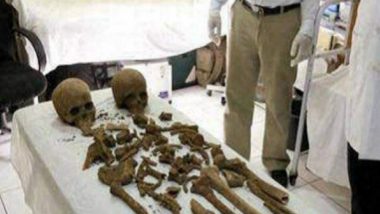Jaipur, May 15: More than three human skeletons, without any ornaments or antiquarian remains, were found recently in the ongoing excavation site of Juna Khera at Nadol in Rajasthan. The site is expected to reveal details of life in the area in the 10th-12th century.
"We will perform carbon dating to know its exact date," says Hridesh Sharma, Director of Archaeology & Museums, Government of Rajasthan, adding that it came as a surprise that these skeletons were only slightly decomposed.
The skeletons were not buried but found in the courtyard and on the floor at the site. For this reason, they may be assumed to be contemporary, but carbon dating would put to rest the questions raised.
On April 30, the second year of the excavation ended. The third season will start in November 2018.
After visiting the site, protected under the Rajasthan monuments and antiquities Act 1961, it was decided by the authorities to re-excavate the site for understanding its town-planning, social stratification, public architecture and cultural sequence of the ancient settlements.
"We expect some crucial information dating back from 10th to 12th century to come out as this is the only site of its kind across the state having tremendous archaeological potential of Chauhan settlement of early medieval period in early 12th century AD," Sharma told IANS.
The surface survey revealed that the site of Juna Khera had a very large settlement. "Hence we felt that there is an urgent need to record its chrono-stratigraphy. It will also be useful to know the function of the township," Sharma added.
He said permission for excavation was sought from the Archaeological Survey of India after proof of human settlement was found during the survey in 2015. Sharma said that in the last two excavation seasons, architectural remains of houses, residential areas and workshops had been exposed.
It was found that residential areas were constructed by locally available granite stone and bricks. Mud mortar was used as binding material in the walls, while iron clamps were used for joining stones of different sizes. Unfinished and finished stones were also seen on the floors. The excavation also revealed traces of living rooms and kitchen with burning activities.
Pottery finished and unfinished beads, coins, iron objects of different types and copper rings were also recovered during this season's excavation work. Seals bearing an inscription in early Devanagari characters were found. The discovery of the coins with the word "La" came as a surprise. These coins could have been issued by "Lakshmana", the founder of the Chauhan branch of Nadol, according to Sharma.
The excavation also revealed a kiln or furnace which indicated a workshop, probably of beads found at the site. One of the trenches had iron implements. "We are trying to establish the cultural sequence of the site," he said.
The excavations also gave evidence of agricultural products used during the era, including wheat, black gram, Moong, Moth, Rice, Arhar and Kulthi. The grains are being sent for study and dating to the Birbal Sahni Institute of Palaeosciences in Lucknow. Soil samples to have been sent. It also came to light that animals such as sheep, cattle and camel were reared for their milk.
Sharma said that artefacts recovered from the site would be displayed at a hall they had in Juna Khera. If they discover more artefacts, one more hall would be built to showcase the material for history lovers, Sharma said.
Many European scholars in the 19th century are known to have visited the site and written about material found there. James Tod, a British Officer in the East India Company and a historian, has given details about the site in his book 'Annals and Antiquities of Rajasthan'. The area was said to be occupied by the Stone Age man since lower palaeolithic period.
(The above story first appeared on LatestLY on May 15, 2018 11:57 AM IST. For more news and updates on politics, world, sports, entertainment and lifestyle, log on to our website latestly.com).













 Quickly
Quickly


